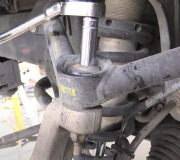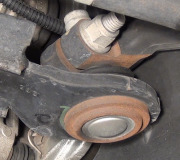Dandy observations. The only thing you can get today is a four-wheel alignment. Old, mechanical equipment from the past was plenty good for those old, heavy, rear-wheel-drive vehicles. They could read to roughly the eighth of a degree, if you were careful.
Today's lightweight, front-wheel-drive vehicles need a real lot more precision. Computerized alignment equipment can read to the hundredth of a degree.
To put this in perspective, imagine a wheel is perfectly straight up and down as you view it from in front of the vehicle, looking back at it. That would be 0 degrees. Now imagine that wheel is tipped out so far on top, that it is laying flat on the ground. That would be 90 degrees. That angle is called "camber" and is one of the three main angles we always look at. Today we need to look at it for all four wheels, not just the front two. By the way, a typically spec for camber is in the area of 0.25 to 0.50 degrees. That's much too small to see without the computer, but it's necessary for best tire wear.
Most manufacturers call for slightly positive camber, meaning the top of the wheel is tipped out on top just a little. That is done for best tire wear and to place the vehicle's weight directly over the wheel bearing so there's less stress on it. For most cars and light trucks, the camber specification results in the wheel being tipped too little to see by eye. A lot of Ford products are the exception. They have some wild specs that make the vehicle ride smoother than those of their competitors, but they don't want you to know the tires wear out in less than half the mileage of other vehicles.
Besides being set as close as possible to specs, it's important that camber be the same on both sides. Tires want to pull in the direction they're leaning. With camber equal on both sides, those pulls offset each other and the car goes straight. In addition to that, we typically set the left wheel just a fuzz higher than the right one. That makes the car want to pull to the left very slightly. We do that to offset "road crown". That's the slant of the roads to the right so water runs off.
To address your specific question about the rear wheels, years ago rear-wheel-drive cars and trucks had solid rear axle assemblies, and we just assumed they were mounted to the frame perfectly straight. The old mechanical equipment showed us where to set "toe" for each front wheel to make them parallel to the frame too. Toe is the last, or third of the three main angles that we set. We place and lock the steering wheel perfectly centered, then turn each front wheel so they're parallel to each other for best handling and tire wear, and so the steering wheel will be straight when driving on a straight road.
Almost all small cars today have independent rear suspension, and as such, camber and toe can be adjusted on them. Most of the time the rear wheels are not perfect, but they're plenty close that there's no need to go through the work of making adjustments. It's very common for rear toe to be unequal, or for both rear wheels to be steering off to one side a little. That's way too small to see as "dog-tracking" if you're following that car, but since the rear is steering to one side, it makes the car go the other way. If the rear wheels are steering to the right, it makes the car veer to the left.
What all computerized alignment equipment does first is it measures camber on all four wheels. At the same time, it measures toe on all four wheels. When it comes to setting toe on the front, instead of showing us where to place each wheel so they're parallel to the frame, it looks at the direction the rear wheels are steering, then calculates where we must place the front wheels to get a perfectly straight steering wheel. It does all the compensating for us automatically. We do have the option to set the computer to just look at the front wheels, but there's no reason to do that, especially since we're almost certain to end up with an off-center steering wheel.
The point of confusion has to do with what you're charged for. You can request a two-wheel alignment that disregards the rear wheels, but we still have to set a projector on all four wheels for the equipment to work. The way we worded this at the dealership I used to work at, was the only alignment available was the four-wheel alignment, but the cost was the same as the older two-wheel alignment. We have no choice but to measure all the angles on all four wheels. We simply ignore the rear wheels unless we see something that really needs to be addressed when we have your best interest at heart. So that one-price alignment got all four wheels measured, but only the two front ones adjusted. That would still leave you with the straight steering wheel.
This way you were getting the first part of the four-wheel alignment. It didn't cost you extra, and it didn't take us any extra time since everything was handled in one "snapshot" taken by the computer. It's when something needed to be adjusted on the rear that we sold you the extra labor. In my case that was an additional 0.3 hours labor per wheel, and around five dollars for a shim. This way you only paid the higher price if work was needed on the rear. Some shops charge a higher price to just measure the rear wheels, then they call that the four-wheel alignment. If rear wheels needed to be adjusted, you already paid for that in the higher price, but if no work was needed on the rear, you also still paid for something that ended up not being needed.
In the '90s, at the Dodge dealership, most cars had solid rear axles. The wheels had to be removed to install a shim, when needed. For each rear wheel, that was usually once or maybe twice in the life of the car. That's where that extra 0.3 hours went. Today, with really lightweight and flimsy suspension systems, it's quite easy for the rear wheels to get out of adjustment, so an alignment every few years is a better value. Along with that, camber and toe are commonly adjusted with adjustable linkages, so the wheels do not have to be removed. Due to the need more often, and because they're easier and faster to adjust, most shops only offer the four-wheel alignment, and it includes any adjustments needed on the rear. The reason the cost of alignments has gone so high in the last ten to twenty years is the extremely high cost of the alignment computers. Also, one of the biggest names in alignment equipment charges a hefty fee each year for updates for the latest models. We had to do a lot of alignments to pay for that equipment.
Hope that helps. Let me know if I missed anything.
Wednesday, November 8th, 2023 AT 6:59 PM


